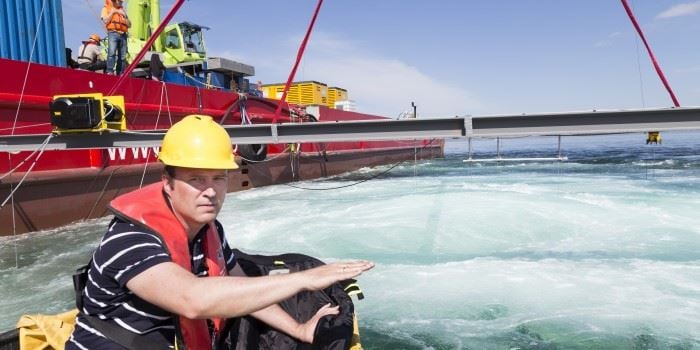The sea boils white as giant air bubbles emerge and burst at the surface. The ten-tonne frame carrying a mass of measurement equipment sways gently on the turbulent surface.
SINTEF researchers Jan Erik Olsen and Grim Eidnes keep a firm grip on the rail of the small boat circling the site of the blow-out experiment. In a real situation, flammable and explosive natural gases would be rising to the surface, but today’s tests involve only air.
It is 22 May, and the field experiment in Trondheimsfjorden is intended to demonstrate first what happens when gas is released at the sea bed, and then how we should organise the recovery of people and equipment.
FACTS:
- SINTEF has established a research project with support from the Norwegian Petroleum Safety Authority, Shell, BP, Statoil, Total, Gassco, DNV and Safetec, with the aim of learning more about the impacts of, and risks linked to, subsea gas blow-outs and discharges.
- Current major emphasis is on methane and other natural hydrocarbon gases, but in the future the project will also be focusing on CO2.
- To date, researchers have carried out tests using rates of between 1 and 2 kg air per second, but need to test at rates of between 10 and 100 kg air per second. Plans for a full-scale experiment in deep water either in Trondheimsfjorden or the North Sea. No confirmed funding as yet, but it is very likely that this will be forthcoming.
A need for more knowledge
Subsea gas blow-outs are a risky business, and the issue is very relevant to the petroleum sector worldwide. Following the accident in the Gulf of Mexico, oil companies have been required to carry out safety analyses before they are awarded new exploration licences. Such analyses require reliable computational models.
Our current knowledge about gas blow-outs is insufficient to enable us to trust the models we use now, and this is why we have to operate with unnecessarily large safety margins. Moreover, all scientific experiments carried out to date have used small volumes of gas. Real incidents, involving large volumes of gas, have not been adequately documented.
Today we want to quantify how much gas will flow to the surface after a blow-out, and how it spreads in the atmosphere. We also need to obtain factual evidence about how close rescue vessels, crews and equipment can approach the “gas cloud”.
Data of global interest
“Look at the yellow cable drums out here on the edges”, shouts Jan Erik Olsen, pointing. “They keep the frame in place under the water”, he says. This frame is equipped with instruments which measure the size and velocity of the bubbles under water. The frame at the sea surface, on the other hand, is fitted with instruments which measure how high the sea rises during the experiment.

The submarine frame is equipped with instruments which measure the size and velocity of the bubbles under water. At the sea surface instruments are installed which measure how high the sea rises during the experiment. Photo: Thor Nielsen/SINTEF
Click to open
The researchers have already developed well-functioning computational models. However, the extent of the turbulence present in the flow has remained an uncertainty factor.
“We have very little quantitative data on this and need more in order to improve our models”, says Olsen. Today’s experiment is studying just this phenomenon”, he says.
The knowledge obtained from this project will also be used to compile reference material on how gas rises upwards and then distributes itself on reaching the surface. This is important, both in connection with field development projects and the preparation of accurate leakage prevention measures.
Since no other research groups have previously held data on these phenomena, the results from this project may be significant for the sector worldwide.


